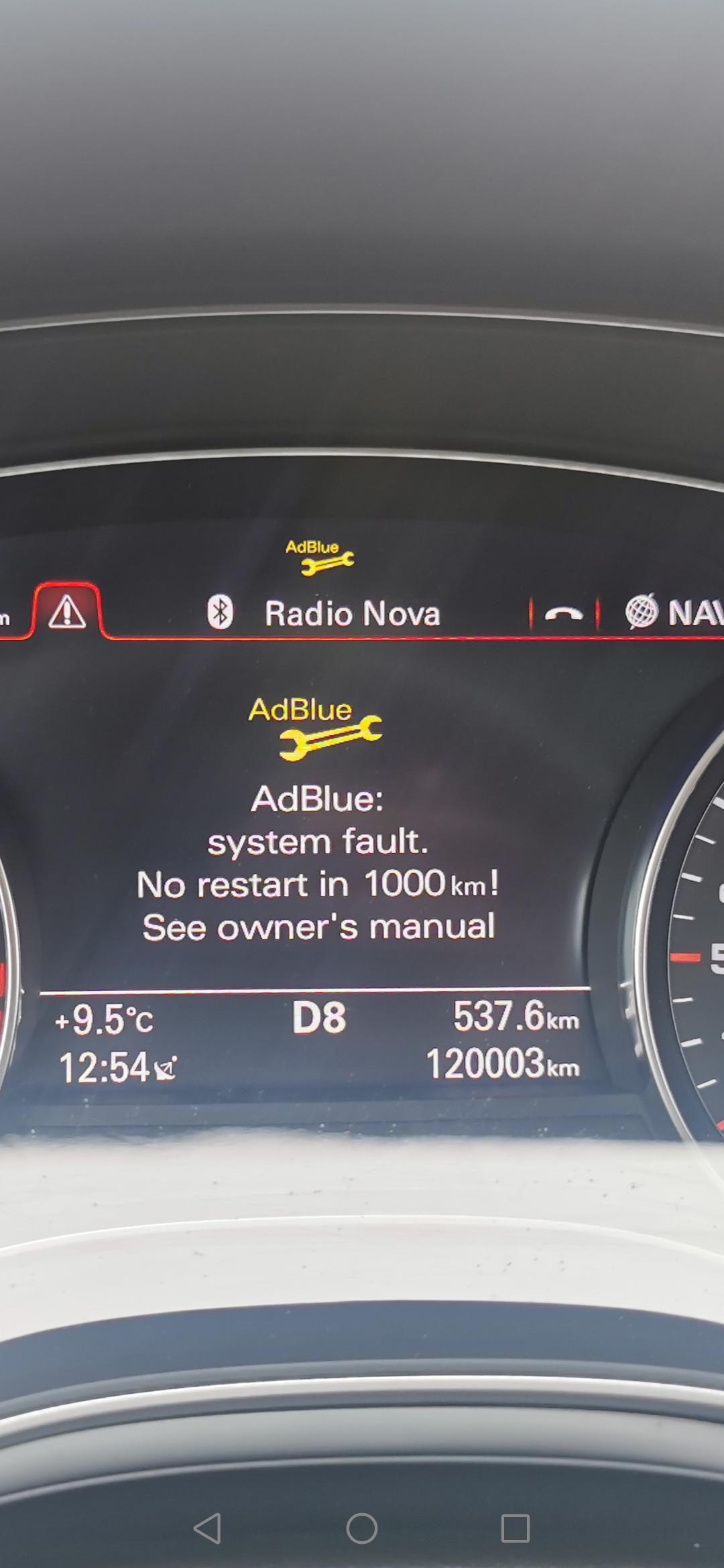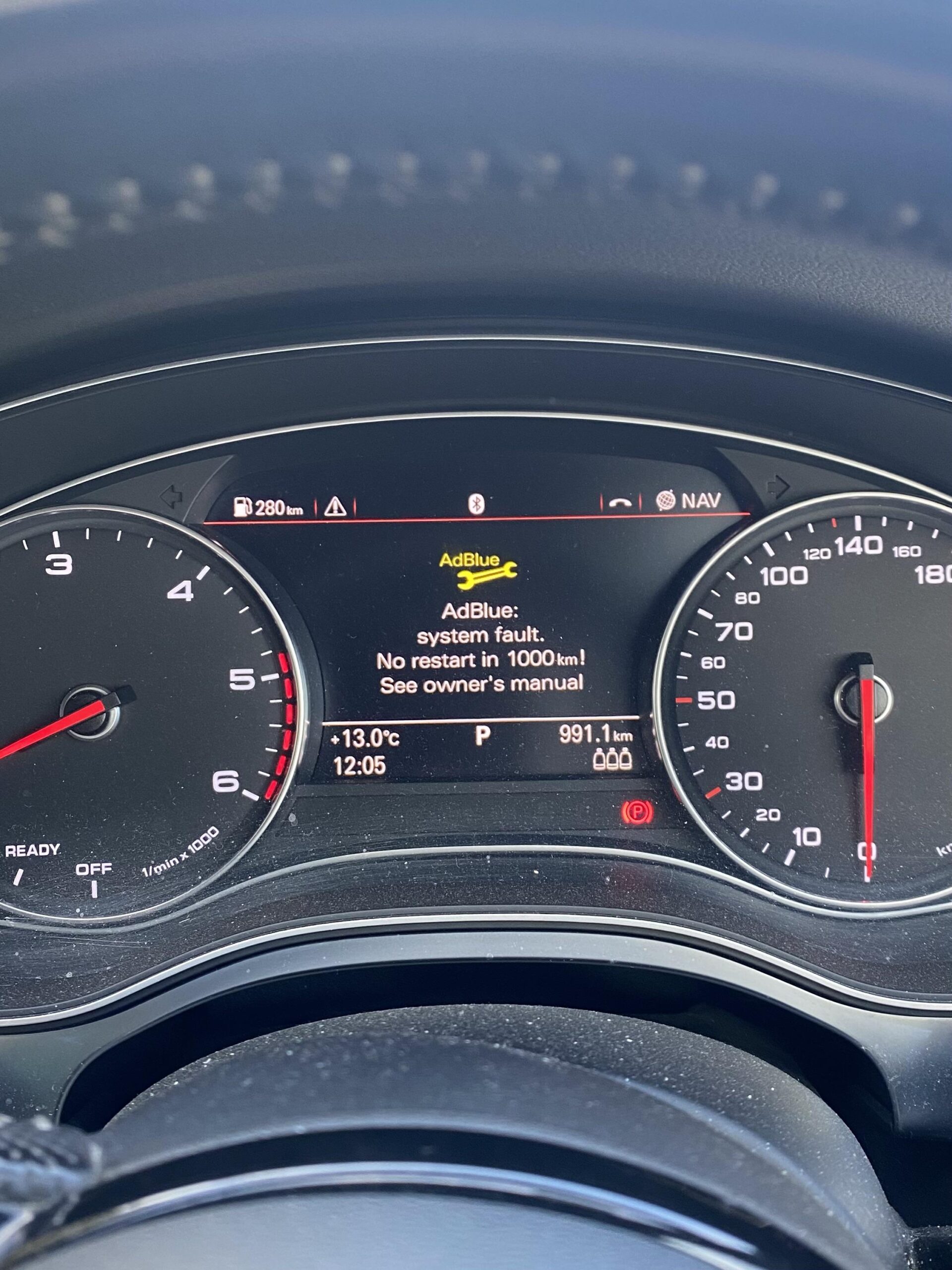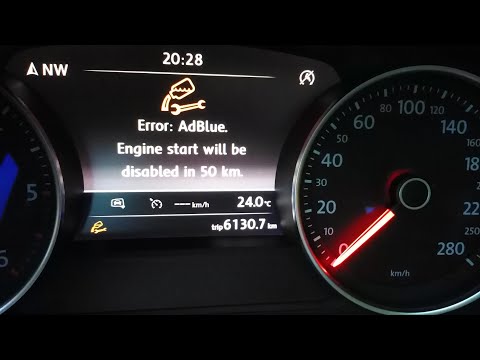What is AdBlue Reset? How to Reset AdBlue?
AdBlue Reset is a critical step after refilling the AdBlue tank in modern diesel vehicles. AdBlue, also known as Diesel Exhaust Fluid (DEF), is a solution made of 32.5% urea and 67.5% deionized water, used to reduce nitrogen oxide (NOx) emissions.
After about 2400 km of driving, the system consumes all the AdBlue, triggering a dashboard warning. Simply refilling the fluid is not enough — your vehicle still requires an AdBlue Reset to clear the warning and allow the engine to operate normally.
In this guide, VCCarTool explains how the AdBlue Reset process works, why it’s necessary, and answers the most common questions to help you maintain both performance and compliance.

What is AdBlue reset?
AdBlue Reset is the process of reconfiguring the AdBlue system after refilling the AdBlue tank. The AdBlue system works alongside the vehicle’s exhaust system and includes components like a tank, pump, sensors, and control units that monitor pressure, volume, and temperature.
When you refill the AdBlue tank, the system needs to recognize the new fluid level and update internal parameters accordingly. This update process is what we call an AdBlue Reset. Without it, the system may continue to display warning messages or restrict engine performance, even if the tank is full.
AdBlue Reset ensures that the newly added fluid is properly detected and the system operates efficiently, keeping emissions low and performance optimal.

Why need to reset AdBlue?
After refilling the AdBlue tank, it’s essential to perform an AdBlue Reset to inform the vehicle’s system that the fluid level is back to normal. This reset clears the warning light on the dashboard and allows the system to recalculate the new AdBlue volume.
If the AdBlue Reset is not carried out, the warning light may remain on—even if the tank is full. In some cases, the vehicle may enter limp mode, a protective function that limits engine power and speed to prevent potential damage to the engine or emissions system.
By resetting the AdBlue system, you ensure that:
- The dashboard warning is cleared
- The system accurately detects the new AdBlue level
- The engine runs normally without performance restrictions
- Emissions regulations are properly met
In short, AdBlue Reset is not just a recommendation—it’s a necessary step to maintain vehicle performance, compliance, and a smooth driving experience.

How to reset AdBlue warning?
Resetting the AdBlue warning depends on your vehicle model and diagnostic tools, but the basic steps remain consistent across most modern diesel vehicles. Here’s a general guide to performing an AdBlue Reset:
Step-by-Step Guide to Reset AdBlue Warning:
Refill the AdBlue Tank
Ensure you fill the tank with the correct AdBlue specification (ISO 22241 compliant). Check your vehicle’s manual for the required capacity.
Switch on the Ignition (Without Starting the Engine)
Turn the key to the ON position or press the start button once to activate the electronics.
Wait for the System to Register the New Level
Some vehicles will automatically detect the new fluid level. Wait 30–60 seconds. If the warning disappears, no manual reset is needed.
Use a Diagnostic Tool (If the Warning Persists)
For most vehicles, especially Mercedes-Benz, BMW, Audi, or VW:
Connect a compatible diagnostic tool (e.g., XENTRY, DTS Monaco, OBD II, or Autel)
Navigate to the AdBlue system or SCR control unit
Select “Reset AdBlue”, “Reset SCR Warning”, or “Relearn Fluid Level”
Clear Fault Codes (If Any)
After the reset, clear any existing error codes and restart the vehicle. The warning light should now be off.
Perform a Short Drive Test
Drive the vehicle for a few kilometers to allow the system to verify and stabilize the new AdBlue reading.
Note:
Some vehicles may not reset automatically and require professional tools and software to complete the process. If you’re unsure or don’t have the tools, VCCarTool offers remote support and AdBlue reset services for most diesel models.
Tips for AdBlue Resetting
Follow these practical tips to ensure a smooth AdBlue Reset process and avoid unnecessary dashboard warnings:
- Locate the AdBlue Tank: The AdBlue tank is usually located under the hood, near the fuel filler, or in the vehicle’s trunk, depending on the make and model.
- Refill Until Full: Fill the tank with high-quality AdBlue (ISO 22241 compliant) until it reaches the recommended level. In some vehicles, the warning light may turn off automatically once the correct level is detected.
- Start the Engine: After refilling, start the engine and let it idle for a few minutes. This allows the system to detect the new fluid level.
- Restart the Vehicle: Turn off the engine, wait a few seconds, then restart it to verify if the AdBlue system has successfully registered the updated level.
- Contact a Technician if Needed: If the warning light remains on or the vehicle enters limp mode, consult a qualified technician or use a diagnostic tool to perform a manual reset.
Need help with a stuck warning light? VCCarTool offers remote AdBlue Reset support using advanced diagnostic software for most diesel models.
Can AdBlue damage a diesel engine?
A common concern among diesel vehicle owners is: Can AdBlue damage a diesel engine? The short answer is no, when used correctly.
AdBlue is a non-toxic solution composed of 32.5% urea and 67.5% deionized water. It’s designed specifically for Selective Catalytic Reduction (SCR) systems in modern diesel engines. When injected into the exhaust stream, AdBlue helps convert harmful nitrogen oxides (NOx) into harmless nitrogen and water vapor, significantly reducing emissions.
Importantly, AdBlue does not mix with diesel fuel and does not enter the engine’s combustion process. As such, it does not harm the engine if used properly and in vehicles equipped with an SCR system.
When Can AdBlue Cause Damage?
While AdBlue itself is harmless, misuse can lead to serious issues:
- Using AdBlue in a non-SCR vehicle can damage the engine or emission components.
- Pouring AdBlue into the diesel fuel tank by mistake can cause severe engine damage and expensive repairs.
- Contaminated or poor-quality AdBlue may clog injectors or damage the SCR system.
Can I run my diesel without AdBlue?
Running a diesel engine without AdBlue is not recommended—and in many cases, it’s not even possible.
Modern diesel vehicles equipped with Selective Catalytic Reduction (SCR) systems rely on AdBlue to reduce harmful nitrogen oxide (NOx) emissions. Without AdBlue, the SCR system cannot function properly, leading to a spike in emissions and potential violations of environmental regulations.
What Happens If You Run Without AdBlue?
- Emission System Failure: Without AdBlue, the vehicle will produce higher levels of NOx, failing to meet legal emission standards.
- Limp Mode Activation: Most modern vehicles will detect the absence of AdBlue and enter limp mode, drastically limiting engine power and speed to prevent damage and enforce compliance.
- Engine Component Damage: The SCR system also protects engine parts from high-temperature exhaust gases. Without AdBlue, certain components can overheat or degrade over time.
- Legal and Financial Penalties: Operating without AdBlue may result in fines or inspection failure in countries with strict emissions laws.
Can I use water instead of AdBlue?
No, you should never use water instead of AdBlue. While AdBlue may look like water, it is a highly specific solution made of 32.5% high-purity urea and 67.5% deionized water, designed to work exclusively in diesel engines equipped with a Selective Catalytic Reduction (SCR) system.
Why Water Cannot Replace AdBlue:
- Incorrect Chemical Composition: Water lacks the urea content needed to convert harmful nitrogen oxides (NOx) into harmless nitrogen and water vapor. Without urea, the SCR system is ineffective.
- System Damage: Using water can corrode components within the SCR system, damage the AdBlue injector, and cause malfunction of NOx sensors or the catalytic converter.
- Emission Test Failure: Vehicles that use water instead of AdBlue will fail emissions tests and violate environmental regulations, leading to potential legal consequences.
- Warranty Voiding: Using incorrect fluids like plain water can void the vehicle’s emissions system warranty and lead to expensive repairs.
- Only use certified AdBlue (ISO 22241 compliant) as specified by your vehicle manufacturer. Substituting water or any other fluid can cause severe damage and result in non-compliance with emission standards.
For help with AdBlue systems, warning resets, or SCR issues, VCCarTool offers professional remote support for most diesel vehicles.
What happens if you mix AdBlue with diesel?
AdBlue must never be mixed with diesel fuel, and it should never be poured into the diesel tank. Doing so can lead to serious engine damage and costly repairs.
Why This Is a Problem
- AdBlue Does Not Mix with Diesel: AdBlue is a water-based solution, not a fuel. When added to a diesel tank, it settles at the bottom and does not blend with diesel, disrupting the entire fuel system.
- Clogging and Damage: AdBlue can clog fuel filters, injectors, and fuel pumps, potentially leading to complete engine failure if the vehicle is started.
- Corrosion of Metal Components: The urea in AdBlue is corrosive to metals. Once in contact with fuel system components such as pumps, fuel lines, and injectors, it can accelerate corrosion and cause permanent damage.
What To Do If You Accidentally Add AdBlue to Diesel
- Do Not Start the Engine: Starting the engine circulates the mixture, worsening the damage.
- Drain the Fuel Tank Immediately: The entire fuel system must be flushed by a professional technician.
- Inspect and Replace Damaged Components: Fuel lines, injectors, and pumps may need to be inspected or replaced, depending on the severity of contamination.
AdBlue should only be added to its dedicated tank—never the fuel tank. If an accident happens, act fast and consult a technician. For remote diagnostic support or technical guidance, VCCarTool is here to help.
More FAQs about AdBlue
Can AdBlue Be Switched Off?
No, AdBlue systems in modern diesel vehicles cannot be turned off. These systems are part of the vehicle’s Selective Catalytic Reduction (SCR) technology, designed to reduce nitrogen oxide (NOx) emissions and meet strict environmental regulations.
Disabling or bypassing the AdBlue system is illegal in many regions and may lead to:
- Heavy fines and legal penalties
- Emission test failures
- Loss of warranty or insurance coverage
Tampering with the AdBlue system may also cause the vehicle to enter limp mode or restrict engine power.
What Are the Disadvantages of Removing AdBlue?
Disabling or removing AdBlue brings several risks:
- Reduced Fuel Efficiency: SCR systems are optimized for fuel economy. Removing AdBlue may reduce engine efficiency and increase fuel consumption.
- Higher Emissions: Without AdBlue, your vehicle emits more NOx—one of the most harmful air pollutants.
- Legal Issues: Removing AdBlue systems violates environmental laws in most countries and may lead to fines or vehicle de-registration.
- Engine Performance Issues: Modern diesel engines rely on SCR logic. Removal may trigger fault codes, reduce power, or damage engine components.
- Emission Test Failure: Vehicles without a functioning AdBlue system are likely to fail periodic emission tests or inspections.
- Warranty & Insurance Void: Manufacturers and insurers may void coverage if the emissions system is tampered with.
- Reduced Resale Value: Vehicles that don’t comply with emissions standards may be difficult to sell or export legally.
How Long Can You Drive Without Adding AdBlue?
The driving range without AdBlue depends on the tank size and consumption rate of your vehicle. Most modern diesel vehicles can travel between 5,000 and 10,000 kilometers (approx. 3,000 to 6,000 miles) per full AdBlue tank.
However, once the AdBlue runs low:
- The warning light will activate.
- If ignored, the system may restrict engine start or power to protect emission control systems.
To avoid disruptions, always refill AdBlue promptly when alerted.
For professional AdBlue reset services, remote diagnostics, or SCR troubleshooting, trust VCCarTool — your expert partner in diesel emission systems.
AdBlue Reset Coding Service at VCCarTool
At VCCarTool, we provide expert AdBlue reset and coding services for vehicles equipped with Selective Catalytic Reduction (SCR) systems. Whether you’ve recently refilled your AdBlue tank or are facing dashboard warnings like “AdBlue level low”, “No engine start in X km”, or “Emissions system malfunction”, our team offers fast and effective remote solutions.
What We Offer
- Remote AdBlue Reset & Parameter Adjustment: We reset the AdBlue system through advanced diagnostic tools (e.g., XENTRY, DTS Monaco, Vediamo) to ensure the control unit correctly detects the refilled fluid.
- SCR Control Unit Coding: We update or reprogram SCR parameters to restore proper fluid level recognition, prevent limp mode, and clear errors.
- Error Code Diagnosis & Deletion: We identify and clear DTCs related to AdBlue level sensors, pump pressure, injection quantity, and other system faults.
- Support for Multiple Brands: We support Mercedes-Benz, BMW, Audi, Volkswagen, Ford, and other major brands with SCR-equipped diesel engines.
When Do You Need an AdBlue Reset?
- After refilling AdBlue but the warning light stays on
- If your vehicle is stuck in limp mode or limited start condition
- When AdBlue-related fault codes appear in diagnostic software
- Following repair or replacement of SCR components (tank, injector, NOx sensor, etc.)
Requirements
To perform the remote AdBlue reset, you will need:
- A compatible laptop with team viewer access
- Diagnostic device (e.g., C4, C6, VAS5054, or similar depending on vehicle brand)
- Stable internet connection
- Software such as XENTRY, DTS Monaco, ODIS, or ISTA (if not available, we can provide setup support)
Why Choose VCCarTool?
- 24/7 Remote Support
- Experienced Technicians
- Global Service Coverage
- Fast Troubleshooting & Safe Coding
Don’t let AdBlue issues limit your vehicle’s performance or legality. Contact VCCarTool now via WhatsApp: +1 (901) 414-1927 or our website for immediate remote AdBlue reset assistance.
